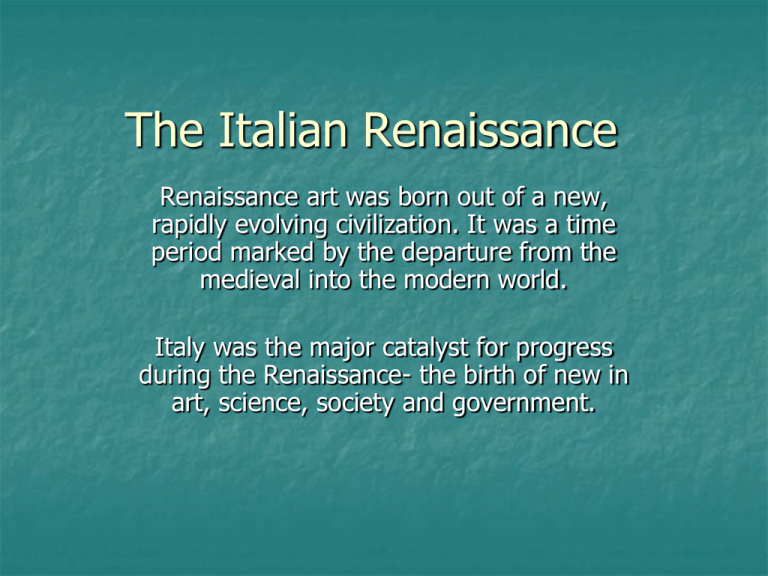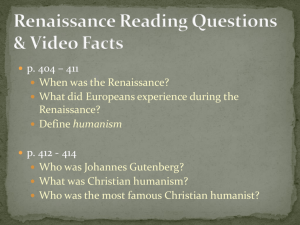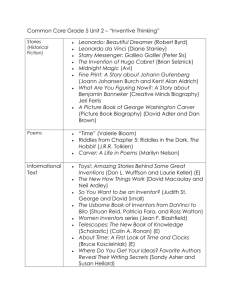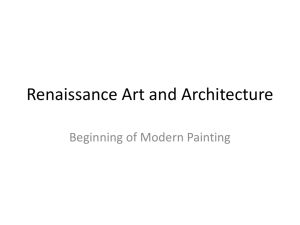The Italian Renaissance
advertisement

The Italian Renaissance Renaissance art was born out of a new, rapidly evolving civilization. It was a time period marked by the departure from the medieval into the modern world. Italy was the major catalyst for progress during the Renaissance- the birth of new in art, science, society and government. Artists to Know: Masaccio Botticelli Da Vinci Michelangelo Titan El Greco Click on image for hyperlink to a video Pieta, Michelangelo, 1490, marble http://www.cedcc.psu.edu/khanjan/europe_images/best_of_europe.htm Renaissance= “re-birth” The Renaissance covers three centuries The rebirth was found in artists, scholars, scientists, philosophers, architects, and rulers. A rejection of the recent past (Medieval and Gothic eras) led them to study the ancient Greeks and Romans. Renaissance Painting Began in the mid 13th century in Italy and quickly spread all over Europe. Humanism and Classicism were very important to these artists. Massaccio was the revolutionary painter of the Renaissance. Born in 1401 In Florence Italy, he died when he was 27. He studied Giotto’s work and included Giotto’s humanity and spatial depth in his work. Adam and Eve Expelled from Paradise, c. 1427, Masaccio http://www.artofcolour.com/fresco/fresco-image-files/masaccio-adam-eve.jpg •Masaccio’s understanding of three-dimensions was greatly owed to the sculptor and architects who came before him. •Sculptural realism lies at the heart of Renaissance painting. •Masaccio studied Donatello’s sculptures-he applied the effects of real light falling onto objects and filtering through spaces. •In Adam and Eve Expelled from Paradise, you see the human emotions of horror, they are blinded with grief and are unaware of anything but their own loss of happiness. Masaccio had a concern for the true appearance of thingspainting shadows with authority and placing people’s feet so that they looked as if they were actually on the ground. St. Jerome and St. John the Baptist, c.1428, Masaccio http://keptar.demasz.hu/arthp/art/m/masaccio/jerome.jpg David, Donatello, This was one of the first nude statues of the Renaissance c.1430 Botticelli Primavera, Botticelli, c. 1482, 10’4” x 6’9”, Tempera on wood http://www.wga.hu/art/b/botticel/5allegor/10primav.jpg Neo-Platonism This was a new school of philosophy that mixed elements from classical Greek systems and Christian beliefs. Botticelli’s Primavera displays a link between nature and humankind. It contains mythical creatures including Venus, Mercury, Zephyr, Chloris, Flora, Cupid and the Three Graces. Cupid was one of the most popular figures in Renaissance art. The High Renaissance The Florentine artists Leonardo da Vinci and Michelangelo, the Umbrian- Raphael, and the Venetian, Titan were some of the greatest artists ever known. A common theme links these four artists: Each artist began his career with an apprenticeship to a painter of good standing. Each took the same path of accepting and then transcending the influence of his master. Da Vinci Leonardo da Vinci- (1452 – 1519) A genius who came from an insignificant background and rose to universal acclaim. His overabundance of talents may have caused him to take his artistry lightly-he seldom finished a picture. “The first object of the painter is to make a flat plane appear as a body in relief and projecting from that plane”da Vinci “Life is pretty simple: You do some stuff. Most fails. Some works. You do more of what works. If it works big, others quickly copy it. Then you do something else. The trick is the doing something else.”Da Vinci Cecilia Gallarani, Leonardo da Vinci, c. 1485 http://home.uchicago.edu/~laporte/music.htm Virgin of the Rocks, da Vinci, c. 1508, Oil on wood http://www.leonardo-davinci.net.au/images/TheVirginoftheRocks.jpg The "Mona Lisa" is a picture of Lisa Gioconda, the real-life wife of a merchant, but that's far from certain. For da Vinci, the "Mona Lisa" was forever a work in progress, as it was his attempt at perfection. The painting was never delivered to its commissioner; da Vinci kept it with him until the end of his life. Today, the "Mona Lisa" hangs in the Louvre Museum in Paris, France, secured behind bulletproof glass, and is regarded as a priceless national treasure. Mona Lisa, oil on panel, da Vinci 1503-1519 SPAIN, March 22, 2012 – “The Mona Lisa”, the most well known painting in the world, has a twin that is now the center of attention. Replica of the Mona Lisa, unveiled in 2012, Painted by an unknown apprentice side by side Da Vinci in his studio The Prado Museum unveiled their Mona Lisa, or “La Gioconda” at a press conference on February 1st and on February 21st to throngs of eager art enthusiasts. Painted by one of Leonardo da Vinci’s disciples simultaneously, between 1503 and 1506, and in the same workshop, “La Gioconda” stands out among all other copies. The painting had been stored in The Prado since 1819, considered one of many replicas painted after Da Vinci’s time. “La Gioconda” is not just a good quality replica. It is virtually identical to Da Vinci’s, yet has one advantage; while the varnish of the original is discolored and faded, La Gioconda’s is as vibrant as Da Vinci fist desired. Using infrared reflectography as they compared both paintings, researchers at The Prado identified corrections made throughout the process, all of which were identical. Thus, they deduced with certainty that Da Vinci and his apprentice painted both side by side. Museum experts narrowed possible painters down to Francesco Melzi and Andrea Salai, Da Vinci’s two best and closest students Michelangelo Buonarroti (1475-1564) Leonardo da Vinci did not exert the influence on future artists like Michelangelo only because his artwork was of another world. Michelangelo resisted the paintbrush, learning from his teacher (Ghirlandaio) how to chisel marble and to draw. Only the power of the pope forced him into the Sistine Chapel and his reluctance led to the world’s greatest single fresco. Beauty was divine to him, one of the ways, he believed, that God communicated with humanity. In the Sistine Chapel, Michelangelo spells out the story of creation in a complex and filled with power. “If you knew how much work went into it, you wouldn’t call it genius”. -Michelangelo http://history.hanover.edu/courses/art/micsis3.jpg http://www.christusrex.org/www1/sistine/0s-Sistine.jpg http://www.twingroves.district96.k12.il.us/Renaissance/SistineChapel/Michelangelo/Michelangelo%20Gifs/sistine3.jpg The Creation of Man, from the Sistine Chapel ceiling, 1511-12 http://www.bioeng.auckland.ac.nz/information/newsletters/nov04/sistine_chapel.jpg David, 1501-04, 14’3” tall, marble http://faculty.evansville.edu/rl29/art105/img/michelangelo_david2.jpg The Last Judgment, detail, west wall of Sistine Chapel, self-portrait as flayed skin being held by St. Bartholomew, 1537-41 http://faculty.evansville.edu/rl29/art105/img/michelangelo_david2.jpg Titan: The “Modern Painter” The third area of art development in Italy was Venice. Bellini taught two artists: Giorgione and Titian Titian’s work incorporated landscapes and poetry into his paintings He became the most sought after portraitist of his day. Man with Gloves, Titian, 1523 Oil on canvas Portrait of Ranuccio Farnese, Titian, 1542, oil on canvas Northern Renaissance The influence of artistic discoveries (scientific perspective and a link back to Greek and Roman art) did not make it’s way to the North for 75 more years. Artists working in Switzerland, Germany, northern France and the Netherlands had a style that developed from a fondness of recreating the visual world. Religious artwork Robert Campin’s Merode Altarpice demonstrates his intuitive perspective (they had no information of the principles of linear perspective in Northern Europe) Despite his inconsistent perspective, his symbolic painting us an example of sheer beauty The Mérode Altarpiece is a triptych by the Early Netherlandish painter Robert Campin (This should be familiar to you, since it was presented in Gothic power point) Symbolism: Mary’s purity is symbolized by the lily on the table, the just-extinguished candle Mary sits on the floor to show her humility, and the folds of her dress, and the way the light plays on them, create a star, probably alluding to many theological comparisons of Mary to a star or stars. The tiny infant on the cross descends into the room from the light in the window symbolizes the embryo of Jesus entering Mary’s womb by God’s will Joseph is working in his carpenter shop On a mousetrap, symbolizing Jesus Trapping the devil. The donors, in the left panel, watch the scene Late Renaissance The High Renaissance is generally thought to have ended with the death of Raphael in 1520. Titian and Michelangelo were still working, however, a new style called Mannerism was emerging. Mannerism Mannerism is a period of European art that emerged from the later years of the Italian High Renaissance around 1520. It lasted until about 1580 in Italy, when the Baroque style began to replace it, but Northern Mannerism continued into the early 17th century.[1] Stylistically, Mannerism encompasses a variety of approaches influenced by, and reacting to, the harmonious ideals and restrained naturalism associated with artists such as Leonardo da Vinci, Raphael, and early Michelangelo. Mannerism is notable for its intellectual sophistication as well as its artificial (as opposed to naturalistic) qualities. The definition of Mannerism, and the phases within it, continues to be the subject of debate among art historians. For example, some scholars have applied the label to certain early modern forms of literature (especially poetry) and music of the 16th and 17th centuries. The term is also used to refer to some Late Gothic painters working in northern Europe from about 1500 to 1530, especially the Antwerp Mannerists—a group unrelated to the Italian movement. Mannerism also has been applied by analogy to the Silver Age of Latin. Madonna with the Long Neck, Parmigianino’s Mannerist work from 1534-40 Mannerism makes itself known by elongated proportions, affected poses and eerie perspective . Château de Fontainebleau The Palace of Fontainebleau, located 55 kilometres from the centre of Paris, is one of the largest French royal châteaux. The palace introduced to France the Italian Mannerist style in interior decoration and in gardens, and transformed them in the translation. The French Mannerist style of interior decoration of the 16th century is known as the "Fontainebleau style": it combined sculpture, metalwork, painting, stucco and woodwork, and outdoors introduced the patterned garden parterre. The Fontainebleau style combined allegorical paintings in moulded plasterwork where the framing was treated as if it were leather or paper, slashed and rolled into scrolls and combined with arabesques and grotesques. Fontainebleau ideals of female beauty are Mannerist: a small neat head on a long neck, exaggeratedly long torso and limbs _ almost a return to Late Gothic beauties Rosso Francois I Gallery, Château de Fontainebleau, France. Rosso Fiorentino, brought Florentine mannerism to Fontainebleau in 1530, where he became one of the founders of the French 16th-century Mannerism called the "School of Fontainebleau". The examples of a rich and hectic decorative style at Fontainebleau transferred the Italian style, through the medium of engravings, to Antwerp and thence throughout Northern Europe, from London to Poland, and brought Mannerist design into luxury goods like silver and carved furniture. A sense of tense controlled emotion expressed in elaborate symbolism and allegory, and elongated proportions of female beauty are characteristics of his style. El Greco's dramatic and expressionistic style was met with puzzlement by his contemporaries but found appreciation in the 20th century. El Greco is regarded as a precursor of both Expressionism and Cubism, while his personality and works were a source of inspiration for poets and writers such as Rainer Maria Rilke and Nikos Kazantzakis. El Greco has been characterized by modern scholars as an artist so individual that he belongs to no conventional school. He is best known for tortuously elongated figures and often fantastic or phantasmagorical pigmentation, marrying Byzantine traditions with those of Western painting.[4] In this, his greatest surviving landscape, El Greco portrays the city he lived and worked in most of his life. Toledo, El Greco "I hold the imitation of color to be the greatest difficulty of art." — El Greco, from notes of the painter in one of his commentaries Click image for fun video on the basic history of the Italian Renaissance El Greco, Adoration of the Shepards, 1596-1600






